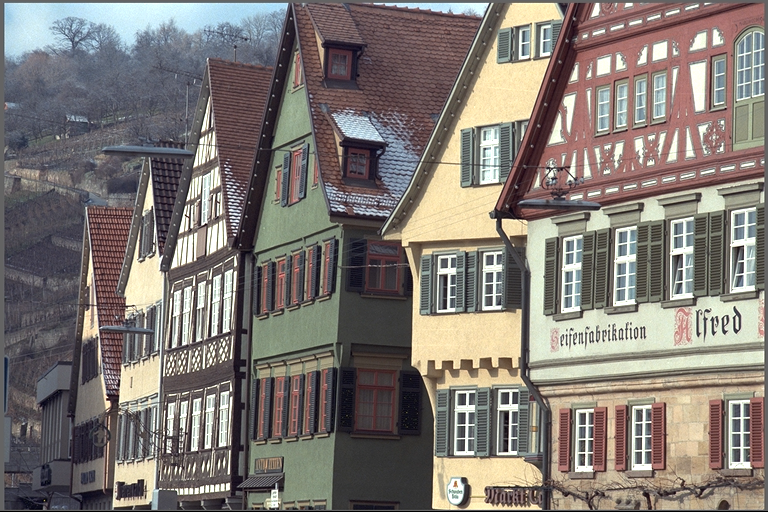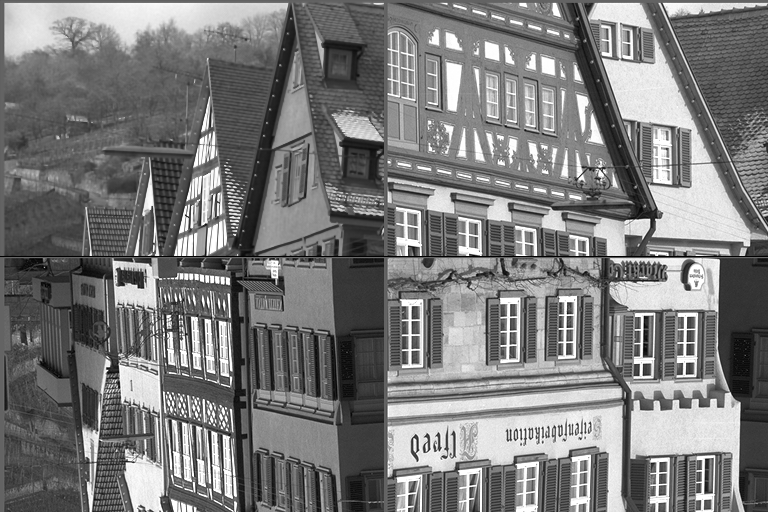图像视图
概述
图像视图应用程序将输入图像分割成 4 个视图,以 2x2 网格排列,对每个图像视图进行不同的处理,可能并行处理并使用不同的后端。处理过程消耗相同的输入父图像,并生成单个输出,将结果作为图像文件保存在磁盘上。您可以定义要处理的输入图像。每个处理使用的后端,以及每个算法及其参数,都固定如下:
- CPU 双边滤波
- CPU 水平方向图像翻转
- CUDA 垂直方向图像翻转
- CUDA 双方向图像翻转
说明
命令行参数为:
<输入图像>
其中
- 输入图像:输入图像文件名;它接受 png、jpeg 以及可能的其他格式。
这是一个示例
- C++./vpi_sample_15_image_view ../assets/kodim08.png
- Pythonpython3 main.py ../assets/kodim08.png
这使用了提供的示例图像之一。您可以尝试其他图像,但需遵守在每个图像视图上运行的每种算法施加的约束。
结果
| 输入图像 | 输出图像 |
|---|---|
 |  |
源代码
为方便起见,以下是在 samples 目录中也安装的代码。
语言 111 CHECK_STATUS(vpiImageCreate(parentWidth, parentHeight, VPI_IMAGE_FORMAT_U8, imgFlags, &inParent));
114 CHECK_STATUS(vpiImageCreate(parentWidth, parentHeight, VPI_IMAGE_FORMAT_U8, imgFlags, &outParent));
140 // Each algorithm runs on a different stream, potentially in parallel, all streams working together
144 CHECK_STATUS(vpiSubmitConvertImageFormat(streams[0], VPI_BACKEND_CPU, imageBGR, inParent, NULL));
156 vpiSubmitBilateralFilter(streams[0], VPI_BACKEND_CPU, inViews[0], outViews[0], 3, 45, 35, VPI_BORDER_ZERO));
159 CHECK_STATUS(vpiSubmitImageFlip(streams[1], VPI_BACKEND_CPU, inViews[1], outViews[1], VPI_FLIP_HORIZ));
162 CHECK_STATUS(vpiSubmitImageFlip(streams[2], VPI_BACKEND_CUDA, inViews[2], outViews[2], VPI_FLIP_VERT));
165 CHECK_STATUS(vpiSubmitImageFlip(streams[3], VPI_BACKEND_CUDA, inViews[3], outViews[3], VPI_FLIP_BOTH));
178 CHECK_STATUS(vpiImageLockData(outParent, VPI_LOCK_READ, VPI_IMAGE_BUFFER_HOST_PITCH_LINEAR, &outData));
声明实现双边滤波算法的函数。
声明处理图像格式转换的函数。
用于处理 VPI 事件的函数和结构。
声明实现图像翻转算法的函数。
用于处理 VPI 图像的函数和结构。
用于处理 VPI 的 OpenCV 互操作性的函数。
VPI 状态代码处理函数的声明。
声明处理 VPI 流的函数。
VPIStatus vpiSubmitBilateralFilter(VPIStream stream, uint64_t backend, VPIImage input, VPIImage output, int32_t kernelSize, float sigmaRange, float sigmaSpace, VPIBorderExtension border)
对图像运行 2D 双边滤波器。
VPIStatus vpiSubmitConvertImageFormat(VPIStream stream, uint64_t backend, VPIImage input, VPIImage output, const VPIConvertImageFormatParams *params)
将图像内容转换为所需的格式,可选择缩放和偏移。
VPIStatus vpiSubmitImageFlip(VPIStream stream, uint64_t backend, VPIImage input, VPIImage output, VPIFlipMode flipMode)
水平、垂直或同时翻转 2D 图像。
VPIStatus vpiImageCreateView(VPIImage imgParent, const VPIRectangleI *clipBounds, uint64_t flags, VPIImage *imgView)
创建图像,该图像包装现有图像的轴对齐矩形子区域。
VPIStatus vpiImageLockData(VPIImage img, VPILockMode mode, VPIImageBufferType bufType, VPIImageData *data)
获取图像对象的锁并返回图像内容。
VPIStatus vpiImageCreate(int32_t width, int32_t height, VPIImageFormat fmt, uint64_t flags, VPIImage *img)
使用指定的标志创建空图像实例。
VPIStatus vpiImageCreateWrapperOpenCVMat(const cv::Mat &mat, VPIImageFormat fmt, uint64_t flags, VPIImage *img)
使用给定的图像格式将 cv::Mat 包装在 VPIImage 中。
Definition: OpenCVInterop.hpp:117
VPIStatus vpiImageDataExportOpenCVMat(const VPIImageData &imgData, cv::Mat *mat)
使用来自锁定的 VPIImage 的 VPIImageData 数据填充现有的 cv::Mat。
Definition: OpenCVInterop.hpp:346
VPIStatus vpiStreamWaitEvent(VPIStream stream, VPIEvent event)
推送一个命令,该命令会阻止处理提交到流的所有未来命令,直到 ...